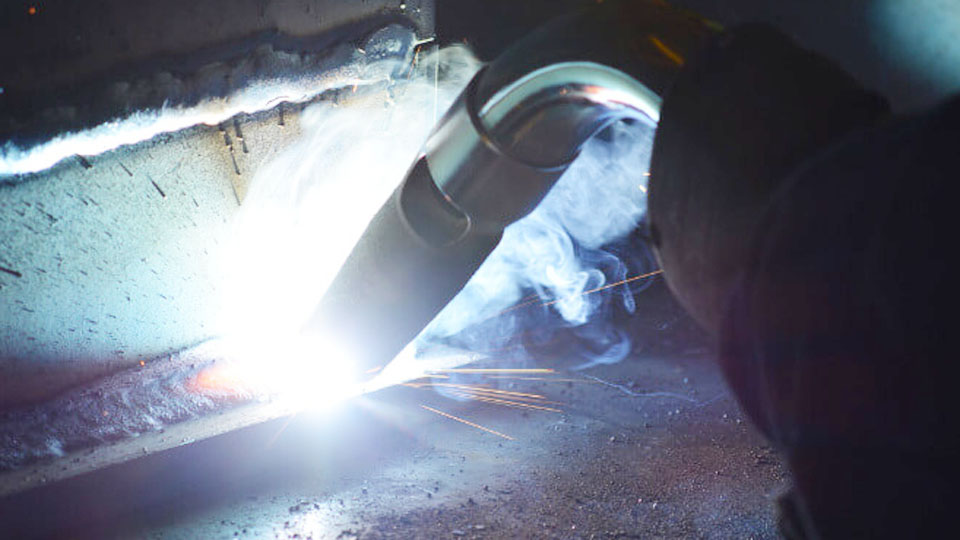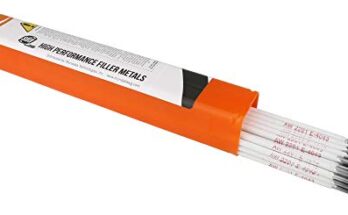Welding stainless steel to mild steel with flux core can be tricky, but it’s definitely possible with the right approach. I remember the first time I tried it—I assumed it would be just like welding two pieces of the same metal.
But stainless and mild steel behave differently under heat, and if you don’t use the right techniques, you can end up with weak welds, excessive cracking, or rust issues down the line.

Image by henlex
If you’re planning to tackle this type of welding, understanding the right settings, materials, and techniques will make a big difference. If you’re working on a fabrication project, repairing metal parts, or doing custom welding jobs, this guide will help you get it right.
Can You Weld Stainless Steel to Mild Steel with Flux Core?
Yes, you can weld stainless steel to mild steel using a flux-cored welding process, but you need to choose the right filler wire and settings to ensure a strong and corrosion-resistant weld. The challenge comes from the different metallurgical properties of these two metals.
Stainless steel contains chromium and nickel, while mild steel is mostly iron with a small amount of carbon. These differences affect how the metals react to heat and how they bond.
Using flux-cored wire makes the process a bit easier since it provides its own shielding, but you still need to be mindful of the filler metal selection and the welding technique.
Choosing the Right Flux-Cored Wire for Welding Stainless to Mild Steel
Selecting the correct flux-cored wire is crucial for a successful weld. The wire acts as the filler material and plays a key role in preventing brittleness, cracking, and corrosion at the joint. Here are some of the best options:
| Wire Type | Best For | Gas Required? |
|---|---|---|
| 309L Flux-Cored Wire | Most recommended for joining stainless to mild steel | No (Self-Shielded) |
| 309LSi Flux-Cored Wire | High-silicon content for better wetting and smoother welds | Yes (Gas-Shielded) |
| 312 Flux-Cored Wire | Best for strength but may be overkill for thin metals | No (Self-Shielded) |
309L is usually the best choice because it has a higher chromium and nickel content, allowing it to bridge the gap between stainless and mild steel. It resists cracking and maintains strength even with the different expansion rates of the metals.
Welding Settings for Flux Core Stainless to Mild Steel
The right settings will depend on the thickness of the materials, but here are some general recommendations:
- Polarity: Use DC Electrode Positive (DCEP) for flux-cored stainless steel wire.
- Wire Diameter: 0.030″ or 0.035″ is best for most applications.
- Voltage: Set between 17-22V, depending on thickness.
- Amperage: Keep between 100-180A based on material thickness.
- Wire Speed: Adjust to maintain a stable arc, typically 200-350 inches per minute (IPM).
If you’re welding thinner materials, go with lower voltage and amperage to prevent burn-through. Thicker materials will need higher settings for proper penetration.
Best Welding Techniques for a Strong Weld
Getting a strong and clean weld when joining stainless to mild steel requires proper technique. Here’s what has worked best for me:
- Use a Slight Drag Angle – Keep the torch at a 10-15° drag angle to ensure a steady arc and good penetration.
- Control Your Heat Input – Stainless steel retains heat longer than mild steel, so avoid overheating to prevent warping and excessive burn-through.
- Keep a Short Arc Length – This helps with penetration and reduces porosity in the weld.
- Use Multiple Passes if Needed – If the metal is thick, use multiple weld passes instead of one high-heat pass to prevent cracking.
- Clean the Joint Properly – Remove any oil, rust, or coatings before welding to avoid contamination.
Common Issues When Welding Stainless Steel to Mild Steel and How to Fix Them
Like any welding process, there are some common challenges you might run into. Here’s how to handle them:
| Issue | Cause | Solution |
|---|---|---|
| Cracking | Too much heat or improper filler metal | Use 309L wire and lower heat settings |
| Porosity (Gas Pockets in Weld) | Contaminants in metal or poor gas coverage | Clean metal before welding and maintain proper torch angle |
| Excessive Spatter | Incorrect polarity or wire feed speed | Use DCEP polarity and adjust wire speed accordingly |
| Corrosion at the Weld Joint | Mild steel contaminating the stainless steel | Use 309L wire and clean up the weld afterward |
Post-Weld Cleanup and Finishing
Once you’ve completed the weld, it’s important to clean and protect the joint. Stainless steel can be contaminated by carbon steel particles, leading to rust over time. Here’s what I do after welding:
- Remove Slag – Use a wire brush or grinder to get rid of any slag left from the flux-cored welding process.
- Passivate the Weld – Use a stainless steel cleaner or acid-based passivation solution to remove iron contamination.
- Protect Against Rust – If the welded piece will be exposed to moisture, consider applying a protective coating or paint over the mild steel areas.
When to Use Gas-Shielded vs Self-Shielded Flux Core for This Weld
While self-shielded flux-cored wire is convenient and doesn’t require a gas tank, gas-shielded flux core produces cleaner and stronger welds. If you’re working indoors or on a project where weld appearance matters, using gas-shielded 309LSi wire with a mix of argon and CO₂ will result in a smoother, more controlled weld.
Self-shielded wire is best when welding outdoors or in high-wind conditions, where shielding gas would get blown away.
Applications for Welding Stainless Steel to Mild Steel
This type of welding is useful in many situations, including:
- Automotive Repairs – Exhaust systems, frames, and custom parts.
- Structural Welding – Bridges, railings, and reinforcement work.
- Food Industry Equipment – Joining stainless and mild steel for durable kitchen or processing equipment.
- Pipe Welding – Connecting stainless and carbon steel pipes in construction or manufacturing.
If your project involves high-strength applications or exposure to moisture, choosing the right wire and technique is even more important to prevent long-term issues.
Conclusion
Welding stainless steel to mild steel with flux core is entirely possible, but it requires careful wire selection, proper settings, and good welding technique. Using a 309L or 312 flux-cored wire will give you the best results, and maintaining a steady arc with proper heat control will help you achieve strong, durable welds.
If you’re new to this type of welding, start with practice welds on scrap metal before tackling your main project. Once you get the feel for it, you’ll see how useful and versatile this process can be for a variety of applications.
FAQs
Can I use regular mild steel flux-cored wire to weld stainless steel to mild steel?
No, regular mild steel wire won’t properly bond with stainless steel and may cause rust and cracking. Always use 309L or 312 stainless flux-cored wire.
Do I need shielding gas for flux-cored welding stainless to mild steel?
It depends on the wire type. Self-shielded wire doesn’t need gas, but gas-shielded wire will produce cleaner welds.
Will my weld rust over time?
If you don’t clean and protect the weld, rust can form, especially on the mild steel side. Using 309L wire and post-weld passivation helps prevent this.
What’s the best flux-cored wire size for welding stainless to mild steel?
0.030″ or 0.035″ diameter wire works well for most applications.





